- Home
- About Us
- Join/Renew
- Member Benefits
- Member Pages
- Log In
- Help
- Museum Store
by Chris Diekman
It is 1931 and the US is deeply mired in the Great Depression. Un-employment is at 16.5% and getting worse. Gas is $0.10 a gallon and the average new car costs $640, if you are fortunate enough to be able to afford one. The new 1932 Pierce-Arrows are coming out soon. It will be the 4th year of the wonderful 8 cylinder, and now the magnificent new 12 cylinder will launch and make its debut.
If you would like to see what it was like to be a Pierce-Arrow Salesman, grab your Rolodex, adjust your Fedora, and come on along for the ride.
A few years back, I obtained an old Pierce-Arrow notebook. It was the sales book for Earl J. Berkley who sold Pierce-Arrows at the Evanston, Illinois dealership in the 1930’s. Here is the building as it appears today at 1819 Ridge Avenue, Evanston, IL. The dealership had all of Cook County, Illinois (basically Chicago) as a sales territory and also had a Main branch in Chicago, and an Oak Park, IL sales branch.
If you recall from the article in The Arrow a couple of years ago, Earl Berkley was one of the winners of the Master Salesmen’s Atlantic Ocean Cruise sales contest in 1933. In going through Earl’s sales notebook, you can get a glimpse of what being a Pierce-Arrow Salesman was like back in the day, when our cars were new and you could smell the un-mistakable aroma of engine paint curing out on a factory painted engine that is warming up in a brand new Pierce-Arrow.
How much is a Pierce-Arrow Salesman Paid?
This is a very interesting question, for in the old notebook was a copy of Mr. Berkley’s contract, the Form P935 Salesman’s Service Agreement. This particular agreement was for 9/1/33. He was employed as a Retail Salesman at the Evanston Retail Branch, in Illinois. From the contract:
“Employee shall have the privilege of selling, upon such terms and conditions as the Company may from time to time fix, new Pierce-Arrow Automobiles and/or Studebaker and/or Pierce-Arrow Commercial Cars, and/or Used Passenger Cars and/or Used Commercial Cars in the territory.”
So it seems that you not only had the “privilege” to sell the cars, but you may also have to work on them, new and used. It is also interesting to note the mention of the Studebaker cars, because this is during the period where Studebaker had bought out Pierce-Arrow. This particular contract was signed a few months after the bankruptcy of Studebaker, and the suicide of Albert Erskine. They must not have issued new P935 forms yet.
Company agrees to pay employee during the term of this agreement or up to the time that employment hereunder is terminated as provided in paragraph 16, a salary of $100.00 per month, payable semi-monthly on the fifteenth and last days of each month.
This means a salary of $1200 per year, which is a little below the national average salary for 1933 which is generally estimated at $1500 per year. But, the contract also included COMMISSIONS!
A Complicated Commission Scheme
Did you ever wonder what the commission was on a new Pierce-Arrow sale? Well at least in 1933, it was a sliding scale that started at a minimum sale of $1000 during the previous month. If you sold $1000 or less that month (selling a used car maybe, or accessories?) then you received no commission for your efforts, just your salary, and you probably had a hard time filling out your P606 Daily Report Form!
The sliding commission scale goes up in 0.1% increments for every additional $100 of sales for that month. The catch is that you get no commission for the first $1000. Then a 4.1% commission on the next $100. On the next $100 of sales, you get a 4.2% commission. In other words, if you sold $1200 in 1 month, the 4.2% commission only applied to the last $100. 4.1% applied to the first $100 (over the initial $1000), and your commission on $1200 would be $8.30.
The commission rate went up 0.1% on every successive $100 increment in monthly sales until it reached a cap of 10.5% at $7500.
As an example, what if you were a good enough salesman to sell a brand new 1932 Model 52 7 Passenger EDL? The delivered Retail Price in Chicago is shown as almost $5200. Your commission would be a cool 8.2% for the last $100 increment, for a total commission of about $258.30. Cha-Ching! We’re in the Money! This is an effective rate of about 5% total commission. If you could just sell a Model 54 Coupe for $3250, you would make a commission of over $113, effectively doubling your salary, at least for that month. It seems like the progressive commission system was at least somewhat of an incentive to sell new Pierce-Arrows, as the sale of 1 car could significantly improve your income for the month.
Also, having sold a car, if you could then sell some accessories to go with the car, according to the scheme, you would get your highest commission, by percentage, on the dealer installed items.
Now before you get carried away, just how many Pierce-Arrow Model 51’s or Model 52’s do you think you can sell in a month? Using Bernie Weis’ estimated production numbers, it is estimated that 2310 of the 1932 models were built. 138 Model 51’s were built and 136 Model 52’s were built. This is a little less than 12% of the 1932 production. If we assume that there were perhaps 50 active Pierce-Arrow dealers at this time, there would have been an average of about 5.5 premium Model 51 or Model 52 cars per dealer for the year. That means one premium model about every other month, on the average at each dealer. It is probable that more total cars and more premium models were allocated to a dealership like Evanston, IL (Chicago sales territory) rather than dealers in smaller less densely populated communities.
To put this in perspective, for the whole model year for 1932, it would have been an average of about 46 new 1932 Pierce-Arrow cars sold per dealer for the year. Again, some dealers were clearly moving more cars than others. However, on the average, this would only be about 4 new cars sold per month for each dealer, and likely 3 of those 4 were Model 54 8-cylinder cars.
This is especially poignant because the sales training information in Earl’s book encouraged salesmen to set a goal of one new car sale per week. Using the example and the assumptions above, if salesmen met this rather aggressive goal, it would only have taken one salesman at each of the assumed 50 dealers to sell the entire 1932 production run in one year. However, given the poor economic times and the fact that there were usually multiple salesmen at each dealership, it is obvious that most salesman could not achieve the one new car sale per week goal. Dealers likely had other revenue streams from other car lines in the dealership, used car sales, sales of accessories, and service, but you can imagine that it was still hard to stay in business when even people with money were hesitant to spend it.
How Much did the New Cars Cost?
Included in Earl’s notebook were the elusive and secret dealer costs for our beloved cars. I have included copies of the Inter Office Letter copies, Form P1505, showing the cost of the various body styles of the Models 52, 53, and 54.
It is interesting that these price memos include the price of a bare chassis, for the proud new owner to take to their favorite custom body shop, even for the Model 54 long and short wheelbases. Typically, you only think of the higher model chassis as being platforms for custom bodywork. It also makes you wonder how many people really came in shopping for a bare chassis. Also note that Model 54 and 53 show a variety of open and closed car body styles, yet the Model 52 offers only closed cars. For whatever reason, there was no price sheet for the Model 51 in the old notebook.
It is perhaps surprising that the dealers had about 25% gross margin on the sales of the new cars AND the accessories. Contrast this with today’s competitive auto market with narrow margins on cars, sometimes selling at “dealer cost”, but the fat margins and much of the profits made on extended warranties, accessories, coatings, treatments, and installation.
From the Rules and Regulations, Pierce-Arrow salesmen were NOT to ask for reductions on the delivered price, delivery cost, or ask for accessories free of charge. This is Rule #31, listed later in this article in “Rules and Regulations for Retail Salesmen”. It makes you wonder if customers still asked for discounts or if they were granted price concessions or if the dealers were able to allow a little more than originally offered on a trade-in to “close the deal”. Rule 31 says not to ask the company for accessories “free of charge”. The way this rule is worded, I wonder if the salesman could at least offer a discount on accessories as a further incentive to buyers.
The “popular” options, at least for 1932 in Chicago appear to have been the chrome radiator shutters, the chrome radiator “grid” or stone guard, and the Archer hood ornament. The kneeling Archer was a very popular option for 1931, with owners of older cars retrofitting it and the enthusiasm carrying over to 1932. Also note that the stainless steel wheels from Budd were listed as an additional stylish option.
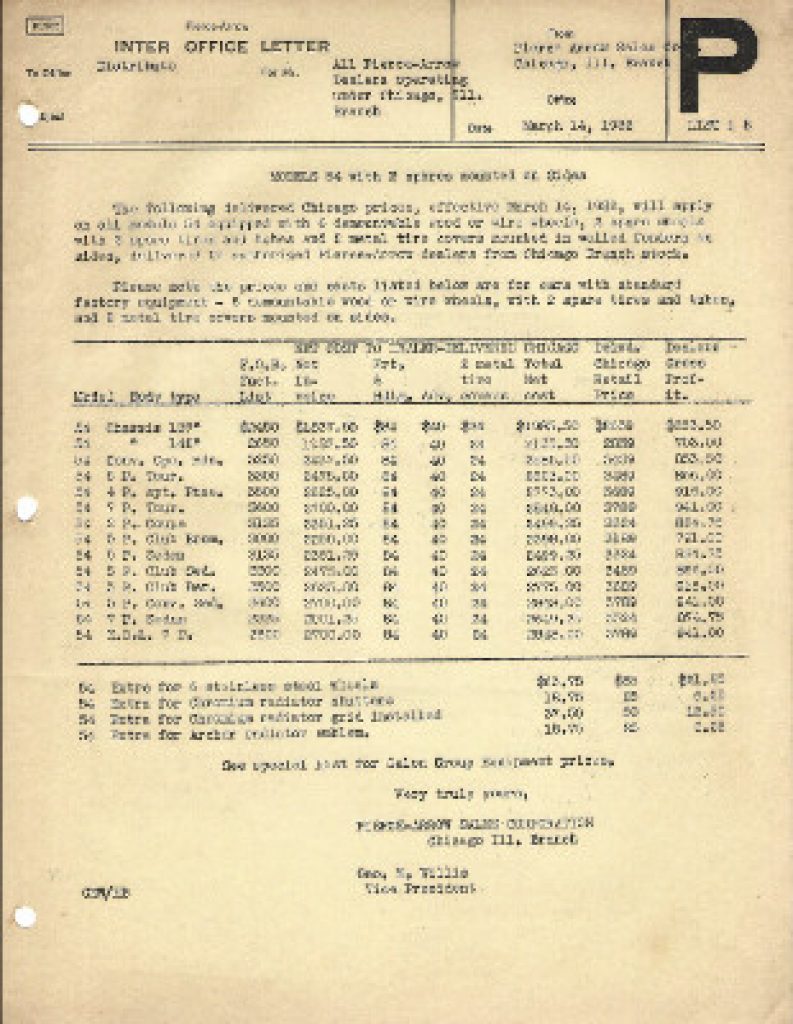 We have come to expect significant shipping or delivery charges for modern cars today. Delivery cost was recently $995 on my pickup truck and while $84 seems like a bargain today in comparison, it was still a fairly substantial cost in 1932 on a car. As a percentage of the price of the vehicle, the delivery charge was still in relative proportion
We have come to expect significant shipping or delivery charges for modern cars today. Delivery cost was recently $995 on my pickup truck and while $84 seems like a bargain today in comparison, it was still a fairly substantial cost in 1932 on a car. As a percentage of the price of the vehicle, the delivery charge was still in relative proportion
Rules and Regulations for Retail Salesmen
Here are some of the more interesting rules and regulations in the Pierce-Arrow Sales Corporation document. The actual list is eight pages and 42 items long.
1. Employee agrees to give his full time to the sale of Pierce-Arrow Motor cars.
Apparently, there were not that many saleswomen back in the day, the Rules and Regulations clearly did not utilize today’s politically correct wording.
3. ATTENDING MEETINGS. It will be a part of the duties of all salesmen to attend the regular meetings whenever called. Tardiness or absence will without previous arrangement with the Sales Manager will result in loss of house prospects for that week.
5. SALESMEN’S OFFICE QUARTERS. No salesman shall remain in the building if not on floor duty, unless waiting to keep an appointment with a customer or engaged in telephoning or attending to other company business.
This seems to be attempt to keep the sales office from becoming a social club and everyone should be working toward generating sales!
8. TELEPHONES. Every employee should understand fully the importance of answering telephones courteously. First impressions are often lasting. When the receiver is taken down to answer a call, the words “Pierce-Arrow Sales Room” shall be spoken into the transmitter, followed by the salesman’s name.
Think about this for a moment, “take the receiver down”, and “speak into the transmitter”. These were apparently wall phones with the separate receiver tethered by the cloth insulated cable and the transmitter affixed to the body of the phone. What a great visual image from days past! Note the emphasis on being polite and courteous to potential customers. Word of mouth advertising was important, even in the 1930’s.
9. DAILY REPORTS. The salesman’s first duty at the close of each day’s business is to turn in the daily report covering his previous day’s work. He will receive at this morning meeting a copy of the Form P606 Daily Report Sheet, carrying in the left part list of the prospects whom he has reported as due for calls on that date. During the day he will then note on the right side the details of his wok on these and other prospects, making appropriate remarks in order that this report may be read for turning in to the Sales Manager at the close of the day’s business. These reports are designed to insure the salesman’s receiving full credit.
There is a great emphasis on documentation of sales prospects and actions taken to convince them to buy a Pierce-Arrow. What emerges is quite a bit of a bureaucracy of paperwork documenting the salesman’s efforts. Note how the salesmen had to account for their time through the day. With falling sales, and fewer and fewer people coming into the showroom, the salesmen must have been quite creative on the form P606 to document a busy day!
12. BOOKING APPOINTMENTS FOR FLOOR DAY. It is expected that during the two or three days immediately proceeding his scheduled time on the floor, the salesman will endeavor to make appointments with his prospects to come to the store at that particular time. Any salesman who spends his floor day in idleness or in working largely with the prospects of other salesmen will be regarded as ignoring this rule.
13. SALES PRACTICE WITHIN STORE. Unless he otherwise states his business, every person entering the sales room is to be regarded as having come to BUY, even though he may say he came to “LOOK AROUND”. People come in because they are interested in Pierce-Arrow cars. Salesmen should keep this in mind if they would not lose business to competitors.
14. APPEARANCE OF SALESROOM. Only Pierce-Arrow Sales Literature is to be displayed in the salesroom; and there must be no posters pertaining to tires, accessories, or anything other than Pierce-Arrow automobiles.
You kind of get a sense for this by viewing old pictures of showrooms. You did not see pyramidal piles of parts on special, stacks of tires, miracle-in-a-can engine elixirs, calls for trade-ins of certain models, or promotional posters.
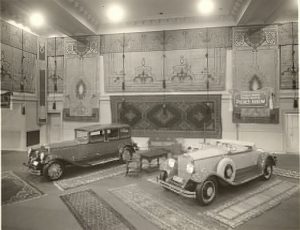
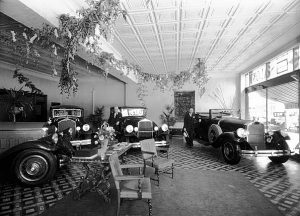
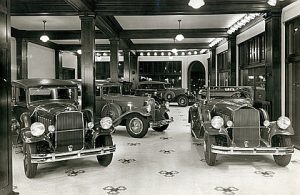
15. APPEARANCE OF CARS ON DISPLAY. Cars on display should be in perfect condition always. There should be no finger marks on hood or fenders or any other part of cars. Windshields and windows should be carefully polished. There must be no spots of oil or grease beneath cars. Seats and interior of cars must always be free from dust and grease. Many sales have been lost because of negligence in this respect.
18. WEARING OF HATS. Salesmen are expected to remove their hats upon entering the salesroom and to keep them off while on the floor.
19. SMOKING IS POSITIVELY FORBIDDEN ON SALESROOM FLOOR. No salesman can be at his maximum alertness while smoking. Tobacco smoke is obnoxious to many customers. To many persons the act of smoking implies a free and easy attitude and one not associated with the most efficient attention to business. If salesmen are not permitted to smoke in department stores selling low priced merchandise, surely they should not smoke where the lowest priced article sells for many hundreds of dollars.
I thought that this rule was amazingly progressive for 1932, since smoking was very common back then and becoming more and more popular.
22. PROSPECTS. New prospects must be filed on Form P606 which must carry the full name, home address and business address. This information is absolutely necessary if the salesman is to obtain the protection desired. Each salesman will be allowed a maximum of 45 days of protection on a prospect, provided he makes a minimum of three productive efforts within the 45 day period.
It seems that if you did the sales work and documented your efforts to work with your sales prospects, there was a protective rule in place to prevent a fellow salesman from swooping in, making the actual sales, and poaching your commission.
25. UNIFORM SALES TALK ON ADVERTISED ADVANTAGES. The Standard method of undertaking the sales of Pierce-Arrow cars shall be to sell the prospect on their advertised advantages. The Pierce-Arrow Motor Car Company and its dealers spend millions of dollars each year to impress these advantages on the public. Your prospects have read this advertising and they expect you to emphasize and drive home these same points. If you fail to do so the prospect reasons that you do not believe in the Companies’ claims. As a result his impression of them is lessened and he may buy elsewhere.
26. SELL ON ONE CALL. Every salesman should do his utmost to sell his prospects on one call. Close scrutiny will be made of the average number of calls required by each salesman to sell his prospects.
27. HAVE ORDER FORMS WITH YOU. Salesmen must carry regular Retail Order Forms at all times. Opportunities to make immediate sales are often discovered unexpectedly and such opportunities must be taken advantage of at once or the sale is lost.
29. USED CAR BUYERS REPORT. All cars offered to us as a part payment on new cars must be inspected by the Used Car Buyer. The Used Car Buyer will inspect the car and make a valuation on Form used for this purpose. The price on the car will be set by the Sales Manager and signed by him on the Buyer’s Report. The original of this report will be given the salesman and the duplicate kept for our files.
This appears to be an effort to keep salesmen from changing the terms of the deal or changing the appraisal of the trade-in without approval. Any “negotiation” on the trade-in price apparently needed to be agreed upon and approved.
30. ORDERS. Orders are written up on the regular Factory Form. We must receive the original and triplicate copy BOTH BEARING THE CUSTOMER’S SIGNATURE. The triplicate copy must be clear and all figures plainly readable.
1. No order will be accepted which does not bear the O.K. of the Sales Manager.
2. No order is to bear an allowance for the used car at a price greater than that set out on the Used Car Buyer’s Report Sheet, unless the change is initialed by the Sales Manager.
There’s that approval again.
3. No orders are to be taken with a used car in trade “Subject to a satisfactory allowance”.
4. A car to be taken in trade which is not turned in on the date of the valuation is subject to revaluation.
5. Used Cars will not be received into stock unless accompanied by registration card or certificate of title made out in the name of the present owner and signed by HIM.
31. FIXED PRICE. All Pierce-Arrow cars are sold at advertised prices, plus freight, preparation charge, added accessories, etc. and stipulated interest on terms if any.
Do not ask the company to deviate from the “delivered” price.
Do not ask the company to take off any freight.
Do not ask the company to include any accessories or supplies free of charge.
This seems pretty clear. No discounts. It seems that the only wiggle room for price negotiation is on the value of the trade-in or the price of the accessories and supplies.
32. ACCESSORIES. All cars are priced by us with standard factory equipment only. Added accessories are sold at our regular established prices.
But then, there is rule 32. Apparently no discount on the accessories. Maybe they allowed a discount on the “supplies”, but you hardly think of a Pierce-Arrow customer trying to get a better deal on a new car by negotiating for discount oil or cheap Prestone for the radiator.
33, CARS IN TRADE. Cars must check up in accordance with the Used Car Buyer’s Report before being received. New cars cannot be invoiced for delivery unless the car in trade has been received and corresponds with the Used Car Buyer’s Report in every particular, including accessories, extra equipment, etc.
34. PAYMENT. Delivery is made to cash customers only upon receipt of CERTIFIED CHECKS OR CASH for the balance due, and care should be taken to notify each customer in advance that such is the case. WE HAVE NO OPTION IN THE MATTER AND CARS CANNOT BE RELEASED UNLESS THEY ARE PAID FOR BY A CERTIFIED CHECK OR CASH.
The P2137 card contained the record for each Pierce-Arrow owner, and the record for each owner of the following makes of cars reported as new car registrations since 1/1/26: Cadillac, Chrysler Imperial, Cord, Franklin, LaSalle, Lincoln, Marmon V 60 (that’s what it says), Nash Advanced, Buick Master, Studebaker President, Packard, and Stutz.
These cards shall be alphabetized and delivered to the branch managers to serve as the master file of potential prospects.
Weekly new car registration reports shall be received, checked, recorded and filed as outlined above. All cards shall be checked with the telephone directory and telephone numbers recorded on the card.
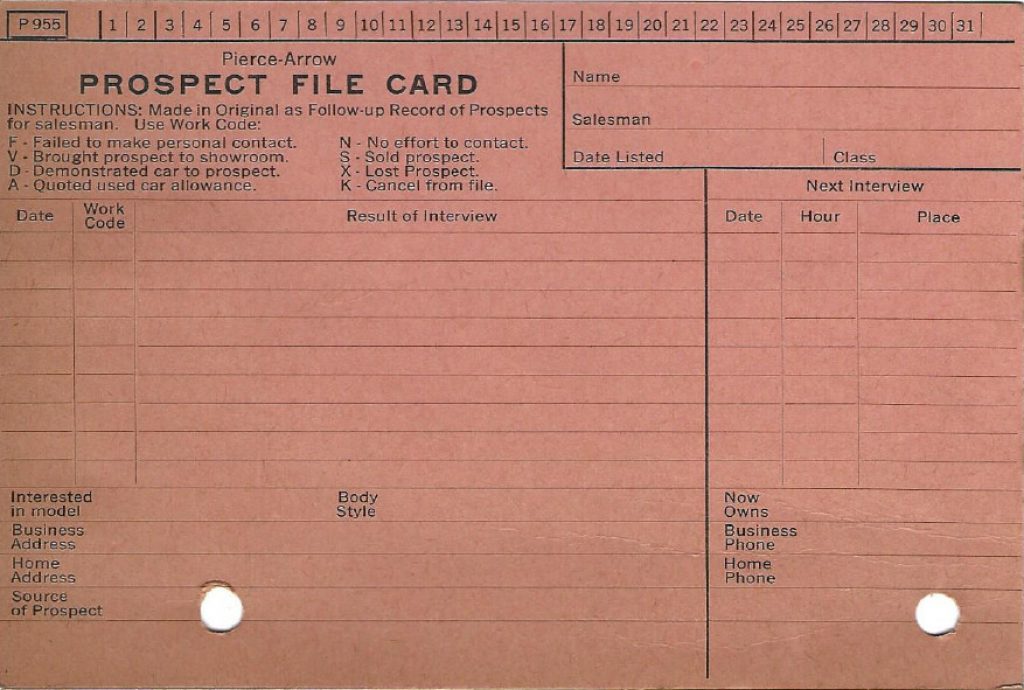
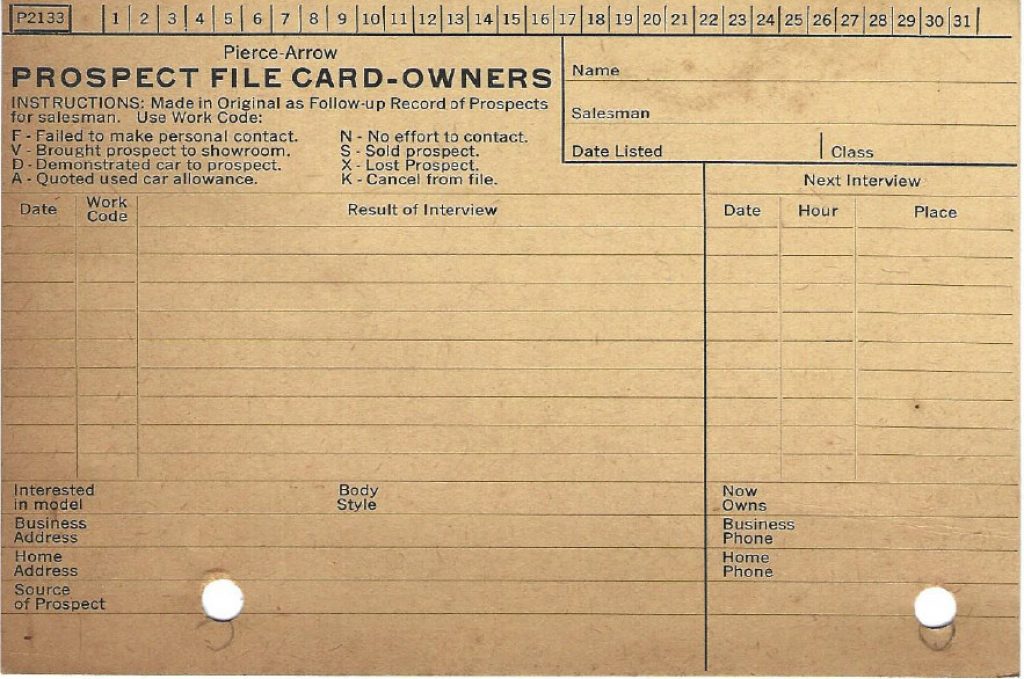
Salesman’s Active Prospect File
A separate Active Prospect file for each retail salesman shall be developed and kept up to date through the following:
A. Pierce-Arrow Owners: The Sales Manager shall arbitrarily assign to each retail salesman a certain number of Pierce-Arrow owners to be actively followed up in accordance with the Sales Meter plan. This will insure regular personal contact with each Pierce-Arrow owner at least once a month oroftender (that’s what it says) if practical. When it becomes evident that the owner is a prospect for a new car, the salesman shall then cover this owner by new car prospect report for Form P2102.
B. New Prospects: On New Prospect Report Form P2102, which shall be made out completely in every detail by the retail salesman, he shall report each day all new prospects uncovered during that day. New Prospect Report Forms P2102 shall be attached to the salesman’s daily assignment and report Form P2090 at the close of business each day.
C. Recording New Prospects: Each new prospect from Form P2102 turned in by a salesman shall be first checked with the master file of Potential Prospects to determine whether the prospect has been previously assigned to some other salesman. If the prospect has not been previously covered by another salesman, an active prospect card Form P955 in case of a Pierce-Arrow owner, or Form P956 in the case of a non-Pierce-Arrow owner, shall be made out by the Sales Manager and filed in the respective salesman’s active prospect file.
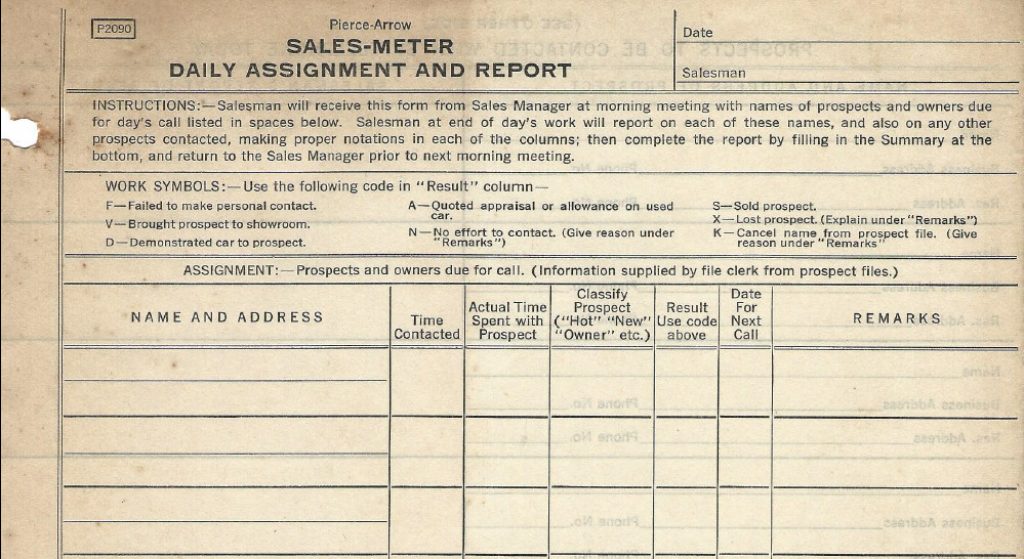
Here is where you need your Rolodex. You’ll need to fill these out for all of your prospects (P955) and all of your current Pierce Arrow owners that may want to trade in their old Pierce-Arrow, (P2133).
D. Development of Salesman’s Active Prospect File: The individual salesman’s Active Prospect File shall be developed expanded and kept up to date through the Sales Manager’s daily assignments on Sales Meter Form P2090 and through the salesman’s own personal efforts as reported on Sales Meter daily report Form P2090.
Form P2090, the “Sales-Meter”. This is essentially your daily activity report. It is unwise to turn this in “blank”, but with a falling market, you can bet that Pierce-Arrow salesmen were highly creative in filling out these forms.
I hope that you have enjoyed seeing this brief glimpse into what it must have been like to be a Pierce-Arrow salesman. It has been fun putting this together and I think it is important to remember what the sales process was like, just as we work to preserve our Pierce-Arrow automobiles.
Happy motoring,
Chris Diekman
